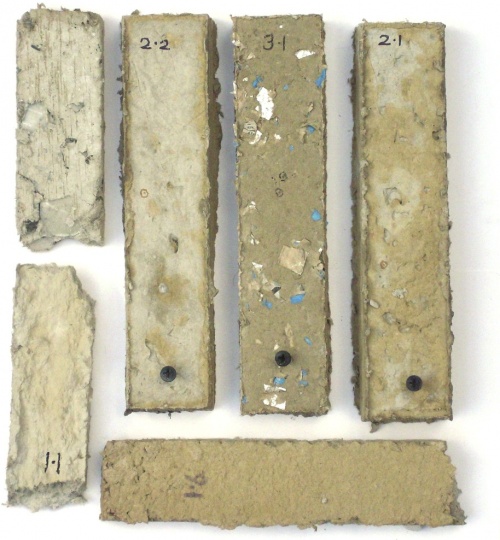Papercrete
Papercrete is a fairly new low cost mortar mix for making blocks, panels, poured walls, roofs, plasters, renders, paving, pond liners, etc.
Papercrete stays strong when wet, and is:
- Rotproof, due to the high pH cement content
- Fireproof, due to the mineral content
- Insulating
- Structural, if rebar or similar is embedded
- Very cheap, as its mostly scrap paper pulp
- Can be screwed into without drilling or plugging
- A good noise barrier
- Bulletproof
Mixes
A typical papercrete mix contains paper pulp, cement and sand. But there are many variations on the theme, with various mixes tailored to for example structural mortar, insulation, waterproof pond lining, paths and so on.
Papercrete is mostly pulped scrap paper, but many other materials can also be incorporated as well as or instead of cement & sand. The following can all be used:
- Lime
- Sand
- Clay subsoil
- Silt
- Wood chippings
- Sawdust
- Expanded polystyrene
- Fibrous weed and plant material
- Broken bricks, blocks, tiles, stone, etc
- Ground brick, tile, glass, stone waste
- Clinker, slag, etc
- Prickly pear cactus paddles have also been added in desert regions to reinforce and waterproof the mix, eg for roofing
Issues
Papercrete's novelty means there is a lack of long term studies on its performance, but the results of its short time of use are very encouraging, with no known degradation or failures in existing buildings.
The main downsides of papercrete are
- Lack of BR approval for use in housebuilding in the UK
- Lack of long term studies
- Need for a paper pulping mixer if making enough to build a house
- Moving the mix into final position takes either a trash pump or a fair bit of labour
The lack of standardisation can also be an issue for new users, who find there are lots of differing recommendations from current users.
Mixers
Standard tumbling cement mixers are no use for papercrete; a shearing action is needed to pulp the paper.
- Paddle in low speed handheld drill can be used to make a bucketload
- Paddle tub mixers (as used for plaster) are good for larger amounts
- For house construction, people usually make their own mixer. There are various designs in use, all paddle mixers of some sort.
Kitchen mixers have been tried for novice experimentation with small batches. Shearing the paper proves a hard load for these, heating the motor more than usual. Motors tend to overheat and die if run too long and not rested enough. Typically kitchen food processors are rated to run for around 10 minutes per hour, and handheld blending wands 2 minutes per half hour. With papercrete these times need to be reduced significantly to avoid overheating. Cement can be added after the paper is all pulped, and mixed in for a minute.
More info
A good starting point, with lots of pretty pics is here: http://www.livinginpaper.com/
